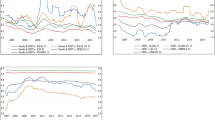Abstract
This research explores the effects of securitization on the market’s perception of banks’ risk exposure between 2002 and 2007. Our results show that, contrary to some prior evidence in the literature, securitizing banks actually had lower systematic betas until 2007. We find no evidence of increasing idiosyncratic risk with securitization. We identify significant structural break in 2007, when securitizing banks experienced jumps in both systematic and idiosyncratic risks. Finally, we confirm the general belief that larger banks tend to have higher systematic risk and lower idiosyncratic risk because of diversification.



Similar content being viewed by others
Notes
Here we distinguish between expected loss and unexpected loss (tail risk). Junior securities in asset securitization absorb most of the expected loss, while investors in senior securities bear some unexpected loss.
It should be noted that different authors use different risk measures. Some studies use accounting risk measures, while we use equity risk measures. One should be cautioned against drawing definitive conclusions from results using different risk measures.
Specifically, if there are two non-negative and positively correlated explanatory variables and the true relation is \( y = {x_1}{\beta_1} + {x_2}{\beta_2} + u \), and if β 2 is positive, then omitting x 2 from the equation could cause the estimate of β 1 to be biased upward.
Schuermann et al. (2006) results show that larger banks have higher market betas than smaller banks.
Another approach is to directly model the bank securitization decision as an endogenous variable and study the impact of securitization with instrument variables. This approach suffers from three major limitations. First, modeling a bank’s securitization decision itself can be complicated, and often results in little model predictive power. Second, choosing the instrument variables often requires a series of assumptions that are hard to test, and the instrument variables often perform poorly. Finally, it is often not the case that a bank’s securitization decision at a given time that affects its risk profile; it is usually the bank’s entire securitization history that produces its current risk profile.
For ease of exposition, we use the same notation for coefficients in both equations although there is no linkage between coefficients in the two equations.
Our decision to measure systematic risk in terms of a bank’s market beta is based on preliminary analysis that the market factor clearly dominates other systematic factors in explaining bank returns. Other macro factors play only a marginal role.
These items are reported in Schedules HC, and HC-B through HC-N, HC-R, and HC-S in the bank holding company database at the Federal Reserve Bank of Chicago.
We exclude Sigma_TB, Sigma_CP, Sigma_Credit, Sigma_Yen, and Sigma_ABS in the final variance regressions because they are highly correlated with Sigma_RM and also highly correlated with each other (pairwise correlations between 0.69 and 0.96).
References
Allen F, Gale DM (2005) Systemic risk and regulation. Wharton Financial Institutions Center Working Paper No. 95-24
Allen F, Carletti E (2006) Credit risk transfer and contagion. J Monetary Econ 53(1):89–111
Ambrose BW, Michael LL, Sanders AB (2005) Does regulatory capital arbitrage, reputation, or asymmetric information drive securitization? J Financ Serv Res 28(1–3):113–133
Cantor R, Rouyer S (2000) Another perspective on credit risk transfer and assets securitization. J Risk Finance 1(2):37–47
Chen W, Liu CC, Ryan SG (2007) Characteristics of securitization that determine issuers’ retention of the risks of securitized assets. Working Paper
Dionne G, Harchaoui TM (2003) Banks’ capital, securitization and credit risk: empirical evidence for Canada. HEC Working Paper Number 03-01
Duffie D, Gârleanu N (2001) Risk and valuation of collateralized debt obligations. Financ Analysts J 57:41–59
Greenbaum SI, Thakor AV (1987) Bank funding modes: securitization versus deposits. J Bank Finance 11:379–401
Hänsel D, Krahnen JP (2007) Does credit securitization reduce bank risk? Evidence from the European CDO market. Working Paper, Goethe University, Frankfurt
Jiangli WY, Pritsker M (2008) The impacts of securitization on US bank holding companies. Social Science Research Network. Working Paper
Krahnen JP, Wilde C (2006) Risk transfer with CDOs and systemic risk in banking. Working Paper No. 2006/04, Center for Financial Studies, Frankfurt University
Landsman W, Peasnell K, Shakespeare C (2006) Are asset securitizations sales or loans? Working Paper, University of North Carolina at Chapel Hill
Niu FF, Richardson GD (2006) Are securitization in substance sales or secured borrowings? Capital market evidence. Contemp Acc Res 23(4):1105–1133
OCC (1997) Asset securitization comptroller's handbook. Office of the Comptroller of the Currency
Schuermann T, Kevin J, Stiroh KJ (2006) Visible and hidden risk factors for banks. Working Paper, Federal Reserve Bank of New York
Thomas H, Wang ZQ (2004) Banks’ securitization and risk management. Working Paper, Chinese University of Hong Kong
Uzun H, Webb E (2007) Securitization and risk: empirical evidence on US banks. J Risk Finance 8(1):11–23
Acknowledgments
The authors thank the anonymous reviewer and the editor of this journal, and participants at the 2008 annual conference of the Financial Management Association for helpful comments.
Author information
Authors and Affiliations
Corresponding author
Additional information
The views expressed in this paper are those of the authors, and do not necessarily reflect those of the Office of the Comptroller of the Currency.
Appendices
Appendix 1
Appendix 2
Appendix 3
Appendix 4
Appendix 5
Appendix 6
Appendix 7
Rights and permissions
About this article
Cite this article
Wu, D., Yang, J. & Hong, H. Securitization and Banks’ Equity Risk. J Financ Serv Res 39, 95–117 (2011). https://doi.org/10.1007/s10693-010-0092-5
Received:
Revised:
Accepted:
Published:
Issue Date:
DOI: https://doi.org/10.1007/s10693-010-0092-5




